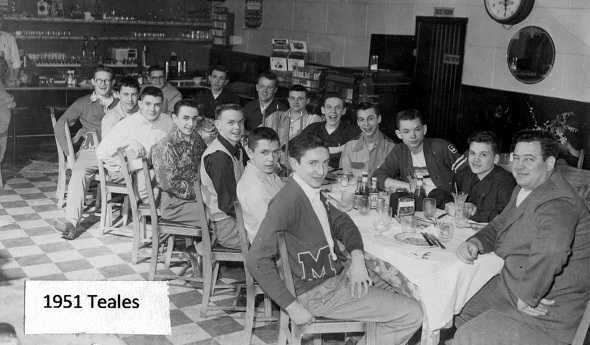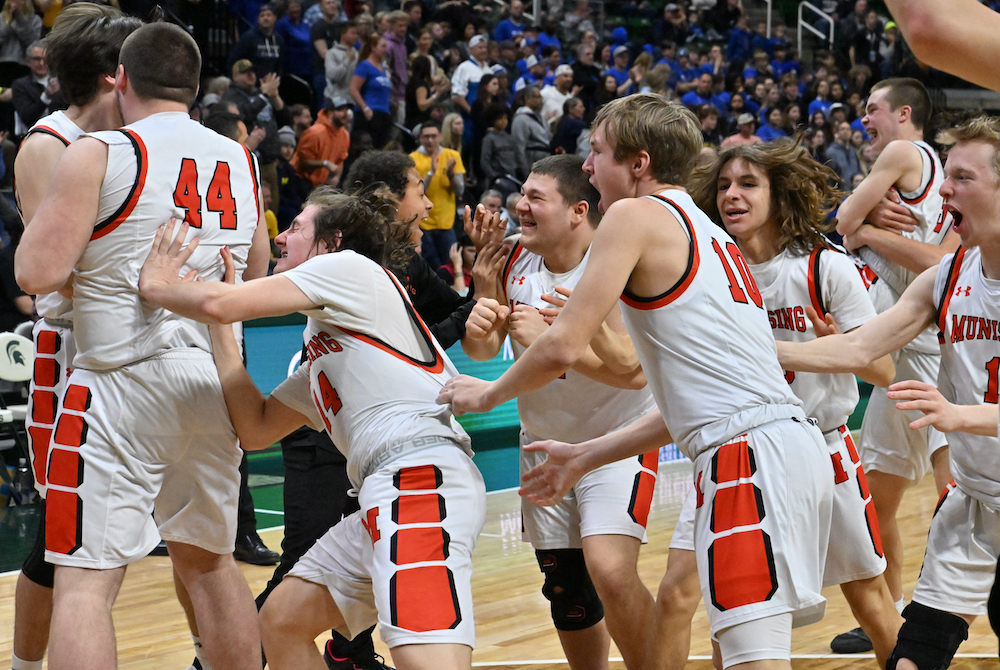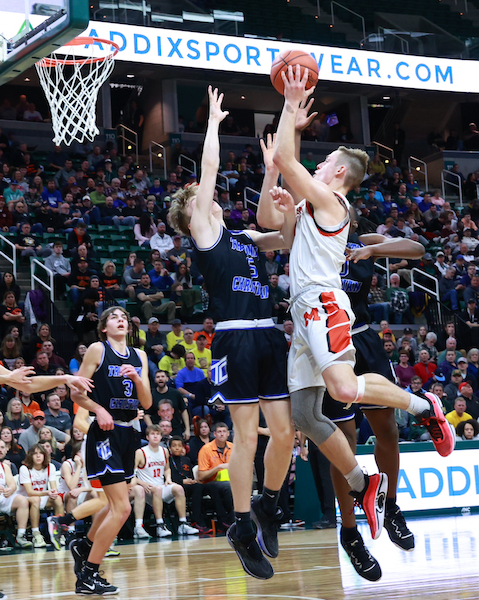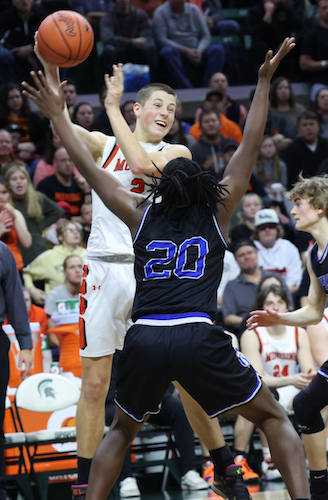
Data Dig Continues for Hoops Histories
March 7, 2017
By Ron Pesch
Special for Second Half
There is a list – well actually two – that sit, unfinished, among the “1,001 Projects I’d Like to Complete Before I Die.”
I became the caretaker of these lists back when I inherited the title “Historian for the MHSAA” in 1993.
The original lists contained the scores of all MHSAA Quarterfinal, Semifinal and Final round games for the MHSAA boys and girls basketball tournaments since their origin.
From the 1930s into the late 1960s, the MHSAA tournament game-day program was generally nothing more than a single sheet document, containing tournament brackets and team rosters for the qualifiers.
 In 1969, the program saw a redesign by Lansing sports personality Tim Staudt and premiered at the MHSAA Tournament. Sold for 50 cents, it included a list of “Past Michigan State Champions” containing the names of the winning teams and those schools’ basketball coaches for each of the four classes. The publication also included a couple of articles from Dick Kishpaugh, the author of the champions list. Kishpaugh was identified as “Sports Information Director at Kalamazoo College and … perhaps the most knowledgeable historian on Michigan high school basketball.”
In 1969, the program saw a redesign by Lansing sports personality Tim Staudt and premiered at the MHSAA Tournament. Sold for 50 cents, it included a list of “Past Michigan State Champions” containing the names of the winning teams and those schools’ basketball coaches for each of the four classes. The publication also included a couple of articles from Dick Kishpaugh, the author of the champions list. Kishpaugh was identified as “Sports Information Director at Kalamazoo College and … perhaps the most knowledgeable historian on Michigan high school basketball.”
With the start of the Girls Basketball Tournament in 1973, a similar program design was followed.
Those lists were faithfully updated and published in the game-day programs in the same format until the 1987-88 school year, when the souvenir publications were expanded. For the first time, a list containing opponents and final scores of the boys and girls championship games was now available to the general public.
Among the first tasks I chose to approach when I assumed the duties of MHSAA historian was to chase more information.
Since Kishpaugh’s lists had game scores for the three final rounds of the tournament, and names of the championship coaches, I thought I would try to leave my mark. I began chasing down the names of coaches for the runner-up, as well as final win-loss records for both schools. And while I was at it, I decided to see what I could find for teams that made the Quarterfinals and Semifinals.
Hundreds of hours have gone into adding to and maintaining the lists, and much progress has been made. Yet, some 20+ years later, I’m still trying to fill holes in the data.
The Basketball Coaches Association of Michigan helped spread the word, notifying its membership of the project. Web pages were created for both the boys and girls to show teams still missing information.
 The pursuit has led to friendships, and fascinating stories, documents and images. The late Walter Michael, who had attended the MHSAA Finals for more than 60 years, donated a cache of MHSAA tournament programs from the 1940s through the 1960s that filled in the names of many high school coaches. Del Newell, a sports writer from the Kalamazoo Gazette, knocked out most of the Kalamazoo schools early in my search. Bill Khan, then of the Flint Journal sports department, filled in a large number of missing names and records from the Flint area. The recently retired “Son of Swami,” better known as Mick McCabe, contributed by including the win-loss records of the quarterfinalists in his annual tournament prognostication columns for the Detroit Free Press.
The pursuit has led to friendships, and fascinating stories, documents and images. The late Walter Michael, who had attended the MHSAA Finals for more than 60 years, donated a cache of MHSAA tournament programs from the 1940s through the 1960s that filled in the names of many high school coaches. Del Newell, a sports writer from the Kalamazoo Gazette, knocked out most of the Kalamazoo schools early in my search. Bill Khan, then of the Flint Journal sports department, filled in a large number of missing names and records from the Flint area. The recently retired “Son of Swami,” better known as Mick McCabe, contributed by including the win-loss records of the quarterfinalists in his annual tournament prognostication columns for the Detroit Free Press.
Numerous coaches around the state sent e-mails and letters with the names and records for their predecessors. Prep basketball fans and former players sent along offerings. Rob Madsen from Mt. Pleasant became a huge contributor, and sent regular updates to both lists. He focused on some of the state’s smallest schools, including many from the Upper Peninsula.
Leon Westover sent the win-loss record for little Marlette, 1951 Class C runner-up, as well as one of my favorite photos from that golden era of prep sports. Marlette had “waltzed through the Mid-Thumb League and district, regional and quarter-final tournament games,” wrote Fred J. Vincent of the Port Huron Times-Herald. Marlette slipped past Stanton 41-37 to advance to the Class C title game against unbeaten Detroit St. Andrew.
“Just one game too many …,” continued Vincent, writing from East Lansing’s Jenison Field House following the title game. “That just about explains the one-sided beating Marlette absorbed in the state class C high school basketball final here Saturday afternoon. The final score was 52-26. … One of the smallest teams, physically, in the tournament, it seemed that the Raiders were just worn out.”
Yet, that night, the team was celebrated like the hometown heroes they really were.
 Westover’s photo shows the Red Raiders on the night of the Final, gathered at Teale’s Restaurant in Marlette. The clock indicates its 11:30. The owner, George Teale, has opened up his restaurant for the team to cook them steaks in honor of their achievement. Coach Nieland "Tommy" Thompson and his 22-2 squad look happy, ready to celebrate a long season.
Westover’s photo shows the Red Raiders on the night of the Final, gathered at Teale’s Restaurant in Marlette. The clock indicates its 11:30. The owner, George Teale, has opened up his restaurant for the team to cook them steaks in honor of their achievement. Coach Nieland "Tommy" Thompson and his 22-2 squad look happy, ready to celebrate a long season.
At tournament time, these lists help answer media requests that arise.
Question: When was the last time two undefeated teams met for an MHSAA Finals championship?
Answer: 2003-Class A for the girls. Detroit Martin Luther King topped Flint Northern 58-53. 1971-Class C for the boys. Shelby downed Stockbridge 71-57.
Question: What coach had the longest span between championship game appearances?
Answer: Eddie Powers, coach of Detroit Northern, went 34 years between his Class A championship team in 1930 and his runner-up squad in 1964. The mark is asterisked, however, as the Detroit Public School League chose to stop participation in the annual state tournament from 1931 through 1961. Saginaw’s Larry Laeding went 20 years between winning the 1942 Class A championship and his squad’s 1962 Class A title. Maple City Glen Lake coach Don Miller went 19 seasons between the school’s 1977 Class D title and its 1996 runner-up finish, also in Class D.
For the girls, both Mary Cicerone at Bloomfield Hills Marian and Carl Wayer at Ashley went 16 seasons between appearances. While Cicerone’s Marian teams have made seven visits to the Finals and have won six Class A titles, 16 years elapsed between Marian’s 1998 and 2014 Class A championships. Marian then captured a second consecutive title in 2015. Coach Wayer advance two teams to the title game. Ashley finished as runner-up in Class D in 1980 and again in Class D in 1996. The loss in 1996 came in overtime, and was the only defeat for Ashley that season.
Michigan’s high school basketball tournaments are an experience shared, mostly unchanged, since their beginnings. At the end of the regular season, everyone qualifies for the madness. Yet in the end, only four teams finish as champions. The path mimics the magical trail taken by fathers, grandfathers and great grandfathers, mothers and grandmothers. Qualifying for the Quarterfinals is still a huge triumph, as the round brings together only 32 teams from a field of more than 700 boys teams and more than 650 girls teams.
In my eyes, these lists emphasize that remarkable, undiluted achievement. In a world consumed with trophies and the number “1,” perhaps it is time to step back and celebrate this rare journey.
Click for Ron Pesch's data "Needs Lists" for girls basketball and boys basketball.
 Ron Pesch has taken an active role in researching the history of MHSAA events since 1985 and began writing for MHSAA Finals programs in 1986, adding additional features and "flashbacks" in 1992. He inherited the title of MHSAA historian from the late Dick Kishpaugh following the 1993-94 school year, and resides in Muskegon. Contact him at [email protected] with ideas for historical articles.
Ron Pesch has taken an active role in researching the history of MHSAA events since 1985 and began writing for MHSAA Finals programs in 1986, adding additional features and "flashbacks" in 1992. He inherited the title of MHSAA historian from the late Dick Kishpaugh following the 1993-94 school year, and resides in Muskegon. Contact him at [email protected] with ideas for historical articles.
PHOTOS: (Top) Marlette's 1951 boys basketball team gathers for dinner at a local restaurant after the Class C Final. (Middle top) The 1969 Boys Finals saw the addition of updated tournament programs. (Middle below) The 1977 Girls Finals program told of the teams that would meet at Jenison Field House. (Below) The 1947 Boys Finals program was among many that helped fill in data gaps from the early years of the tournament. (Photos provided by Ron Pesch.)

Munising Powers Past Reigning Champ to Claim 1st Finals Title
By
Keith Dunlap
Special for MHSAA.com
March 25, 2023
EAST LANSING — There is an old saying that the heart of a champion should never be underestimated.
But in this case, it was the heart of the challenger that couldn’t be underestimated.
After seeing a six-point lead turn into a one-point deficit during the fourth quarter of the Division 4 Boys Basketball Final on Saturday, Munising seemed to be on the ropes trying to dethrone 2022 champion Wyoming Tri-unity Christian.
But from there, it was Munising which made the championship plays.
The Mustangs scored six straight points, and ultimately did enough to hold on for a 39-37 win over the Defenders.
It was the first Finals title for Munising, and chants of “UP Power! UP Power!” rained on the court from the Munising fans as the team celebrated afterwards.
 “A lot of our games have been this way this year,” Munising head coach Terry Kienitz said. “We come out fighting and scrapping the whole game. A lot of times we get a good lead and lose it, but we always keep fighting and the next guy makes a big shot.”
“A lot of our games have been this way this year,” Munising head coach Terry Kienitz said. “We come out fighting and scrapping the whole game. A lot of times we get a good lead and lose it, but we always keep fighting and the next guy makes a big shot.”
Munising held a 25-19 lead with 3:07 remaining in the third quarter, but Tri-unity Christian went on a surge and took a 30-29 lead with 3:46 left in the game on a layup by senior Roy Fogg.
Then, Munising took over.
First, senior Cully Trzeciak hit a 3-pointer from the wing to give Munising a 32-30 lead with 2:10 remaining.
The play run for that shot was called “Herro,” after Miami Heat guard Tyler Herro, but it was appropriate because it turned Trzeciak into a town hero forever.
“On Thursday (in the Semifinal), I was kind of in a slump and missed a lot,” Trzeciak said of his only 3-point attempt in this game. “But shooters shoot. You’ve got to keep shooting, and it felt good.”
Sophomore Trevor Nolan then stole an errant inbounds pass and went in for an uncontested layup with 2:02 left to make it 34-30 Munising.
Senior Kane Nebel then made a free throw with 1:07 remaining to give the Mustangs a five-point lead. Tri-unity Christian made it 35-32 with 45.1 seconds left on two free throws by Fogg, but Munising took a 37-32 lead with 33.6 seconds to go on two free throws by sophomore Carson Kienitz, and then went up seven on two free throws by Nebel with 18.6 seconds left.
 Things did got a little dicey at the end for Munising, as Tri-unity Christian cut its deficit to 39-35 with 13.6 seconds left on three free throws by junior Owen Rosendall and then made it 39-37 with 2.8 seconds left with a basket by Rosendall.
Things did got a little dicey at the end for Munising, as Tri-unity Christian cut its deficit to 39-35 with 13.6 seconds left on three free throws by junior Owen Rosendall and then made it 39-37 with 2.8 seconds left with a basket by Rosendall.
But Munising successfully inbounded the ball, avoided a foul and dribbled out the clock to start its celebration.
Nebel – whose grandfather Chuck Nebel played on the last Munising team to reach the Semifinals in 1954 – had 14 points, six rebounds and six assists to lead the way for Munising (27-1), which overcame a 39-17 rebounding advantage by Tri-unity Christian.
Junior Jordan VanKlompenberg scored 15 points and Fogg added 11 for Tri-unity Christian (22-7), which was making its third-straight appearance in the championship game.
The Defenders shot 31.1-percent from the field and made just 4 of 19 shots from 3-point range.
“I was disappointed in our offense,” Tri-unity head coach Mark Keeler said. “I felt we showed a lot of impatience and a lot of bad shots. But I don’t want to take anything away from Munising. They had a great team and they played great defense.”
PHOTOS (Top) Munising players celebrate the team’s first Finals championship Saturday at Breslin Center. (Middle) The Mustangs’ Kane Nebel (0) gets to the basket for a shot with Wesley Kaman (5) defending. (Below) Munising’s Carson Kienitz (2) tries to get a pass past Tri-unity Christian’s Akais Giplaye (20).

